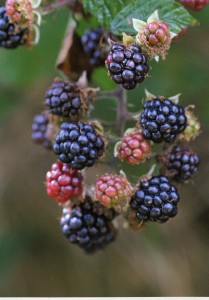 There are still a number of people in the Highlands who, each year, gather berries and fruits from the wild and use them for a variety of purposes. Bramble gathering is, in some areas, still a pastime and I collect some most years. The berries, sometimes called blackberries, are used in a variety of ways and an increasingly popular one is to make a junket from them. Some people just eat them as they come off the bush although a good way of serving them fresh is to leave them to steep overnight in red wine. If you collect a few raspberries from the wild then use them for stuffing game birds or if you have more then use them in pies, tarts and other preserves, as well as jellies. Later in the year people gather rowan berries especially to make into the jelly that goes so well with venison. My own favourite are the berries of blackthorn, called sloes and I not only make the famous sloe gin from them but also sloe whisky. There are many other recipes for a variety of berries and for that matter flowers and the number of books on the subject grows every year. It was perhaps epitomised by one of the first books on the subject namely “Food for Free” written by Richard Mabey and first published in 1972.
There are still a number of people in the Highlands who, each year, gather berries and fruits from the wild and use them for a variety of purposes. Bramble gathering is, in some areas, still a pastime and I collect some most years. The berries, sometimes called blackberries, are used in a variety of ways and an increasingly popular one is to make a junket from them. Some people just eat them as they come off the bush although a good way of serving them fresh is to leave them to steep overnight in red wine. If you collect a few raspberries from the wild then use them for stuffing game birds or if you have more then use them in pies, tarts and other preserves, as well as jellies. Later in the year people gather rowan berries especially to make into the jelly that goes so well with venison. My own favourite are the berries of blackthorn, called sloes and I not only make the famous sloe gin from them but also sloe whisky. There are many other recipes for a variety of berries and for that matter flowers and the number of books on the subject grows every year. It was perhaps epitomised by one of the first books on the subject namely “Food for Free” written by Richard Mabey and first published in 1972.
There are also the other aspects about wild flowers, shrubs and trees which these days is largely forgotten. Not only were they used for culinary purpose but also in medicine and other practical purposes such as the dyes for clothing including the tartans. So widespread was the use of wild plants, now largely forgotten, that virtually any plant seen in the Highlands these days would have had a variety of uses. Some of these developed locally as in the old days travelling and the spread of new ideas were very restricted. Travelling people were few and far between so when the Drovers with their groups of cattle they took to distant parts down south to the trysts arrived they would have been welcome with all their news. The droving days took place mainly in the 19th century and must have spread the word over a numbers of changes that were taking place in the countryside.
There was also the question of where people lived. For example people on St. Kilda who wanted to use plants dyes for their tartans would have had to use different plants than, say, the people around Inverness. Another good practical example is in the basic need of buildings, the roof covered with somewhat primitive thatch. Reed was the best thatch but it just did not grown in many parts so alternatives had to be found. One widespread and often abundant plant was heather and this was probably used more than any other covering for thatch. Along the coast people used marram grass whilst in other areas even bracken, sedge, rushes, broom and even iris were used .
If you look on roadside verges, in woodland, the edges of lochs or along the coast there are very few plants that would not have had their use in the past. One small, inconspicuous plant is eyebright that is found throughout the mainland and most of the islands including the Western and Northern Isles. The flowers are small, less than a centimetre across, but it was widely used as an eyewash and believed to be able to restore failing eyesight. The Highlanders in particular used it to make an infusion of eyebright in milk and painted it onto sore and irritating eyelids with a feather.
